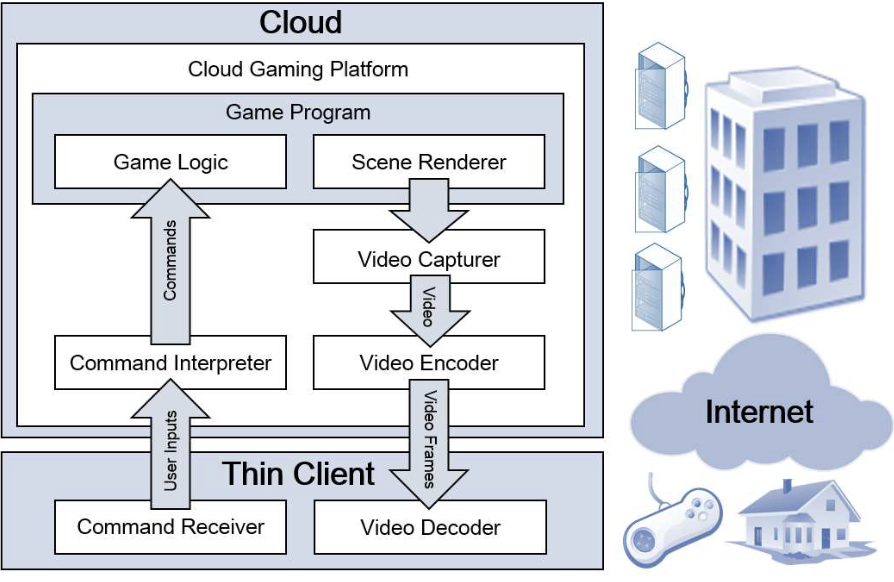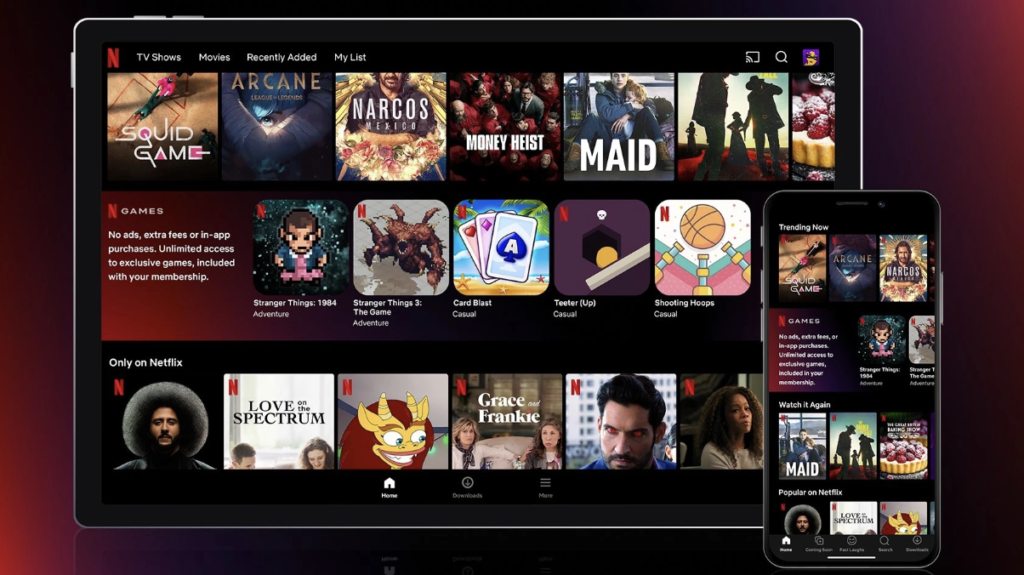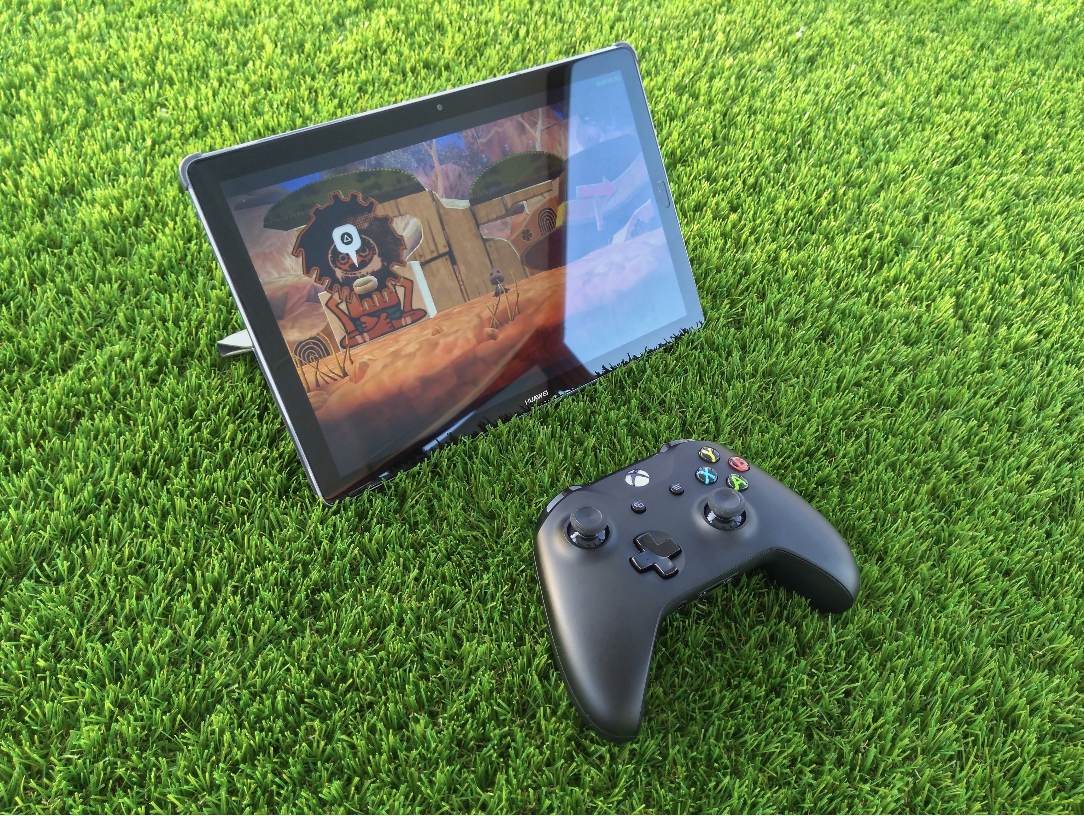
Introduction
Cloud gaming services have gained significant traction in recent years. They allow users to play high-quality games without needing powerful hardware. This technology revolutionizes the gaming industry by enabling gamers to stream games on-demand, regardless of their device’s capabilities. One key benefit of cloud gaming is that it eliminates the need for downloading and installing games or upgrading hardware. Players can access a vast library of games instantly and stream them in high quality without worrying about device limitations. Additionally, cloud gaming services offer flexibility, allowing players to pick up and play from where they left off on any device.
As a relatively new technology, cloud gaming enables gamers to stream games over the internet rather than playing them locally on a console or PC. In this setup, the game runs on a remote server, with video and audio output streamed to the player’s device. This system allows players to enjoy games on various devices, including smartphones, tablets, and low-powered laptops, without investing in expensive gaming hardware.
However, the quality of a cloud gaming service can vary depending on factors such as network latency, server capacity, game optimization, and more. In this blog post, we’ll explore what cloud gaming quality means and how understanding these factors can help gamers make informed decisions about selecting cloud gaming providers.
Technical overview

A Cloud Gaming Architecture is the underlying framework that essentially enables the delivery of video games through streaming from remote servers to the users’ device.
The general, high level Cloud Gaming architecture consists of game servers that render and process games, encoding and streaming systems to deliver the content, Content Delivery Network for efficient content distribution, client devices for decoding and displaying the game, and adaptive streaming mechanisms to ensure a smooth gaming experience. I will give a brief description of these components.
Game Servers
These servers are the core of the cloud gaming architecture, responsible for running and rendering game instances. high-performance servers equipped with powerful CPUs, GPUs, and ample memory to run and render multiple game instances simultaneously. These servers are typically hosted in geographically distributed data centers, ensuring low latency and efficient resource allocation for users worldwide. Virtualization technologies, such as containerization or hypervisors, are used to run multiple game instances on a single server, optimizing hardware utilization with great success (Kämäräinen et al., 2015). Game servers may be hosted in data centers strategically located around the world to minimize latency and ensure a smooth gaming experience for users
Game Streaming and Encoding
Once a game is rendered on the game server, it must be encoded into a video format suitable for streaming. This involves converting raw video frames into a compressed format using video codecs, such as H.264, VP9, or H.265/HEVC. These codecs employ various techniques, including motion estimation, motion compensation, and transform coding, to achieve high compression efficiency while maintaining acceptable video quality. Adaptive bitrate streaming (ABR) algorithms, such as DASH or HLS, are used to dynamically adjust the video quality based on network conditions and device capabilities. The encoded video is then sent to the user’s device over the internet.
Data Transfer and Protocols
The encoded video stream is transmitted to the user’s device, the thin client, over the internet using streaming protocols, such as RTP (Real-time Transport Protocol), RTSP (Real-time Streaming Protocol), or WebRTC. These protocols handle packetization, synchronization, and error recovery, ensuring reliable and real-time delivery of video data. Adaptive bitrate streaming algorithms like DASH or HLS are used to adjust the video quality based on network conditions and device capabilities, ensuring a smooth gaming experience.In addition, cloud gaming platforms often use custom transport protocols, such as Google’s QUIC or NVIDIA’s NVFBC, to further optimize latency and throughput.
Content Delivery Network (CDN)
To minimize latency and ensure optimal performance, cloud gaming platforms typically rely on a Content Delivery Network (CDN). CDNs are networks of interconnected servers that cache and distribute content to users from the server closest to their location. CDNs consist of interconnected servers that cache and distribute content to users from the server closest to their location. This reduces the distance data must travel and minimizes the risk of network congestion. Popular CDN providers, such as Akamai, Cloudflare, or Amazon CloudFront, are used by cloud gaming platforms to enhance performance and scalability. This helps to reduce the distance data must travel and minimize the risk of network congestion, resulting in a smoother and more responsive gaming experience.
Client Devices and Decoding
Users can access cloud gaming services on various devices, such as PCs, smartphones, tablets, or even smart TVs. These devices must be equipped with the necessary software to decode the incoming video stream and display the game on the screen. Modern GPUs, such as NVIDIA’s Tegra or Qualcomm’s Adreno, are often used for hardware-accelerated decoding, reducing power consumption and latency. Software decoding is also possible, but may result in higher CPU usage and increased latency. Decoding involves converting the compressed video stream back into raw video frames that can be rendered by the device’s display.
Input Handling
In cloud gaming, user inputs (such as controller, keyboard or mouse actions) must be transmitted back to the game server to control the game. This introduces additional latency, as inputs must travel from the user’s device to the game server before being processed. To minimize this latency, cloud gaming platforms employ various techniques, such as local input prediction, which predicts the outcome of user inputs on the client device before receiving confirmation from the server. Cloud gaming platforms aim to minimize this latency to ensure a responsive gaming experience comparable to playing games locally.
Adaptive Streaming and Quality Control
To provide a seamless gaming experience, cloud gaming architecture often employs adaptive streaming techniques. These techniques adjust the quality of the video stream in real-time based on the user’s internet connection, device capabilities, user preferences and so on. Machine learning algorithms, such as reinforcement learning or neural networks, can be employed to optimize bitrate selection, frame rate adaptation, and quality control. This ensures that the stream remains smooth and uninterrupted, even under less-than-ideal network conditions.
Breaking Down Cloud Gaming Quality
Essentially, all these components that that describe cloud gaming have one primary focus – transferring the video stream and user input data efficiently and with minimal latency.
Since Cloud Gaming service providers are usually businesses in a highly competitive and fast-paced market, its is vital to identify unique selling propositions for business success. From great importance is the ‚Quality’ of the product or service.
But what exactly is quality in a context of cloud gaming and what is the meaning of it? Quality in the context of cloud gaming can be closely associated with the concepts of Quality of Experience (QoE) (Laghari et. al 2020), which refers to the overall user satisfaction with a gaming service and Quality of Service (QoS) (Gupta & Dutta, 2015) which is defined by the reliability of the underlying network and infrastructure that supports the gaming service. QoS focuses on the ability of the system to deliver a consistent and high-quality gaming experience by managing and prioritizing network resources, such as bandwidth, latency, and packet loss.
Enhancing both QoS and QoE is crucial for delivering a high-quality cloud gaming experience. To optimize QoS, cloud gaming providers can implement various strategies, such as traffic shaping, prioritizing gaming traffic, or using CDNs to minimize latency and improve network performance (Gupta & Dutta, 2019). On the other hand, improving QoE involves addressing user-specific requirements, such as adaptive video streaming (Laghari et al., 2020), optimizing game settings based on device capabilities (Cai et al., 2016), and improving input handling techniques to minimize latency and enhance responsiveness (Jarschel et al., 2011). QoS is measured objectively by collecting and evaluating data e.g. network performance etc. while QoE is subjectively by gathering data through surveys from users about their gaming experience. In essence, one can say QoS is more on the technical side of Cloud Gaming while QoE focuses on the social aspect.
Both aspect must be considered and optimized together to ensure user satisfaction and maintain the competitiveness of cloud gaming services in the market.
By analyzing studies and literature, I want to find out the most significant quality factors for cloud gaming.
Quality factors
In the following I listed Important factors of quality in Cloud Gaming, differentiated between the classes of QoS and QoE. The order of sequence is not of importance and doesn’t indicate one quality factor being better than the other.
Quality of Service (QoS) factors:
- Latency: The time it takes for data to travel between the client device and the cloud gaming server. Low latency and fast response times are crucial for a seamless cloud gaming experience. It directly impacts the player’s experience and immersion in the game (Baldovino, 2022)
- Bandwidth: The amount of data that can be transmitted over the network per unit of time and the consistency and reliability of the network connection between the client device and the cloud gaming server. A stable network connection and sufficient bandwidth are crucial for uninterrupted cloud gaming. Network stability is important to prevent disconnections or lag, while bandwidth ensures high-quality streaming (Cai et al., 2016b).
- Packet loss: The percentage of data packets that are lost during transmission over the network. Packet loss can lead to video and audio glitches, as well as disruptions in gameplay. High packet loss can make the gaming experience frustrating for users, as they may miss critical in-game moments or experience inconsistent game performance. Minimizing packet loss is essential for maintaining a stable and seamless gaming experience (Möller et al., 2018).
- Jitter: It refers to the variation in latency over time. High jitter can cause gameplay to be uneven or stutter, which can be particularly disruptive in fast-paced games. Low jitter ensures consistent and smooth gameplay, enhancing the overall gaming experience (Huang et al., 2014).
- Network stability & Server Performance: A stable network connection ensures that the cloud gaming service can maintain a consistent and reliable data stream between the client device and the cloud gaming server. Network instability can lead to interruptions in gameplay or poor performance, negatively affecting the user experience. Efficient server performance is critical for processing and rendering game content in real-time. Poor server performance can result in slow loading times, low frame rates, or gameplay glitches. High-performance servers ensure a smooth and responsive gaming experience for users (Shea et al., 2015; Shea et al., 2013).
Quality of Experience (QoE) factors:
- Video quality & Frame rate: The visual clarity and sharpness of the game video stream as experienced by the user. Video quality and frame rate are essential for a visually appealing and immersive gaming experience. High video quality with a consistent frame rate ensures that the gameplay appears smooth, while low video quality or inconsistent frame rates can lead to a less enjoyable experience for the user (Lin & Shen, 2018).
- Responsiveness: It is the measure of how quickly the game reacts to user inputs, such as button presses or mouse movements. In cloud gaming, a highly responsive game allows users to feel more in control and engaged, while poor responsiveness can lead to frustration and decreased enjoyment (Chuah et al., 2014).
- Device compatibility: The ability of the cloud gaming service to work seamlessly with various client devices, such as smartphones, tablets, or PCs. Support for various input devices, such as game controllers, keyboards, and mice, is essential for a versatile and accessible cloud gaming experience (Laghari et al., 2020).
- Audio quality: High-quality audio is vital for an immersive gaming experience, as it can enhance the game’s atmosphere and provide important audio cues to the player. Poor audio quality or audio synchronization issues can negatively impact the player’s engagement and overall gaming experience (Wen & Hsiao, 2014).
- Content availability: The selection and variety of games available on the cloud gaming platform. A diverse game library and support for multiple platforms, including PCs, consoles, and mobile devices, make the cloud gaming service more appealing to a broader audience (Möller et al., 2018, Biradar & Nagoor, 2017).
- Pricing & Business Model: The pricing structure and business model of a cloud gaming service can significantly influence the user’s perception of value and overall satisfaction. Affordable pricing plans and flexible subscription options can make cloud gaming services more accessible and appealing to users, while overly expensive or restrictive plans may deter potential customers (Gupta & Dutta, 2019).
- Customer Support and Reliability: Reliable customer support is important to ensure users can quickly resolve any issues they may encounter while using a cloud gaming service. Effective customer support and service reliability can increase user trust and satisfaction, while inadequate support can lead to frustration and dissatisfaction (Laghari et al., 2020).
- User interface and usability: A user-friendly interface and intuitive controls can significantly enhance the overall Quality of Experience in cloud gaming. An easy-to-navigate system helps users quickly find and access the games they want to play, while a complicated interface can be frustrating and deter users from fully utilizing the service (Cai et al., 2016).
Essentially and speaking in a highly simplified manner, It all breaks down to a User Experience combined with technical implementation. It is from most utter most importance, to optimize these pieces of the Cloud Gaming Service.
Example: Assessing the of quality of controversial Cloud Gaming services
Now that we have identified essential factors for Cloud Gaming services, let’s evaluate a few. I decided to assess presumably controversial or discontinued services for several reasons: to learn from failures, to hypothesize the success of one Cloud Gaming service based on the identified quality factors, and to avoid providing free advertisement.
Google Stadia

Google Stadia, a Cloud Gaming Service by Google LLC, launched in November 2019, promising instant 4K, 60 FPS gameplay streamed through a screen of choice. However, it failed to deliver on its promise, wasn’t profitable for Google LLC, and shut down in January 2023. What happened?
I identified key reasons for Google Stadia’s failure concerning the quality factors, which are described below.
1 – Platform & Perfomance
imited device compatibility was a significant issue for Google Stadia during its initial launch. Stadia’s cloud gaming service relied on specific hardware and software requirements to enable streaming and input handling, which initially limited the number of supported devices.
Initially, Stadia was only compatible with a limited number of devices, including Google’s Pixel smartphones, Chromecast Ultra, and desktops with Google Chrome browser support. This restricted access to the platform and made it less appealing to users with non-compatible devices. Several technical reasons limited the platform’s compatibility:
- Video Codec Support: Stadia used the VP9 video codec for video streaming, which offers better compression efficiency compared to other codecs like H.264. However, not all devices supported the VP9 codec, limiting the range of compatible devices (Warren, 2020).
- Input Handling: Stadia required devices to support specific input handling protocols to ensure seamless communication between the gaming controller and the cloud gaming server. Some devices might not have had the necessary support for these protocols at launch (Ruben, 2019).
- Hardware Performance: Stadia’s video streaming and decoding process required a certain level of hardware performance to ensure smooth gameplay. Devices with lower-performance hardware may have struggled to provide a satisfactory gaming experience, leading to initial compatibility restrictions (Warren, 2020).
Despite Google’s vast infrastructure, many users experienced latency and performance issues with Stadia, resulting in a suboptimal gaming experience, especially for fast-paced and competitive games. Google Stadia faced criticism for its latency issues, with some users reporting input lag of up to 100-200 milliseconds or more, highly detrimental to gameplay. High latency can be attributed to various factors, such as network congestion, server processing time, and the encoding/decoding process for streaming video content (TheKLF, 2022).
Stadia launched without several promised features, such as family sharing and 4K streaming on all devices. Stadia promised 4K resolution and HDR support at launch, but many users experienced video quality issues due to compression artifacts, resolution scaling, and inconsistent frame rates. These issues could be attributed to the video encoding process, where the balance between compression efficiency and visual quality is crucial to delivering an optimal gaming experience (Ruben, 2019).
Stadia’s high-bandwidth requirements (up to 35 Mbps for 4K streaming) meant that users with slower internet connections, data caps, or inconsistent network performance faced difficulties when attempting to use the service. This limitation restricted Stadia’s accessibility and adoption, as many potential users could not enjoy a seamless gaming experience due to their internet connection constraints (Hamilton, 2019).
This created a barrier to entry for potential users and made the platform less appealing to a wider audience.
2 – Pricing
When considering a Cloud Gaming/Streaming service, users often think of a subscription model. However, that wasn’t the case with Google Stadia. Stadia’s pricing model, which required users to purchase individual games in addition to a monthly subscription fee, was criticized for being less attractive than competitors’ offerings. Google Stadia offered two subscription models: A base tier with a few free-to-play games and a Pro tier for $10 a month, which included more free-to-play games and 4K gameplay on an irregular basis. This strategy proved unsuccessful in the case of Google Stadia.
3 – Game Selection
At the time of launch, Stadia’s game library was relatively small compared to established competitors such as Xbox Game Pass and PlayStation Now. This limited selection of games made it difficult for Stadia to attract new users and retain existing ones. Additionally, games purchased on Stadia were only accessible as long as the service existed, undermining the purpose of Cloud Gaming and an important quality factor: content availability and usability.
4 – Lack of support
Google Stadia faced criticism for its lack of features and support at launch, which contributed to its underwhelming reception. Many key features were missing or limited at launch, despite being promised during marketing campaigns, such as:
- Achievements: Stadia did not launch with a fully functional achievements system, which is a standard feature on other gaming platforms. Achievements provide players with additional goals and rewards for completing specific in-game tasks, enhancing the gaming experience. This feature was eventually implemented, although it took some time (Google Stadia: How To See Achievements, 2021).
- Family Sharing: At launch, Google Stadia lacked a family sharing feature, making it difficult for families with multiple users to share purchased games across their accounts. This absence limited the platform’s appeal to families and multi-user households (Bradshaw, 2020).
- Wireless Controller Support: The Stadia controller initially required a wired connection to devices other than the Chromecast Ultra, limiting its usability and convenience. Full wireless support for other devices was added later (Bradshaw, 2020).
- Stream Connect and State Share: Two of Stadia’s advertised features, Stream Connect and State Share, were not available at launch. Stream Connect enables local split-screen gaming via cloud gaming, while State Share allows players to share specific game states with others. The absence of these features reduced the platform’s appeal and the potential for unique gaming experiences (Bradshaw, 2020).
- Social Features: Stadia lacked robust social features like integrated voice chat, messaging, and friend list management at launch, limiting the platform’s ability to foster a gaming community (Hollister, 2019).
Conclusion
The failure of Google Stadia was inevitable. In conclusion, Google Stadia was a bold attempt by Google to enter the cloud gaming market with the promise of delivering high-quality gaming experiences on a wide variety of devices. However, several factors contributed to the platform’s failure. Key issues included limited device compatibility, latency and performance issues, an unappealing pricing model, a limited game library, and a lack of features and support at launch. These shortcomings hindered Stadia’s ability to compete with established gaming platforms and attract a broad user base, ultimately leading to its discontinuation.
Despite its ambitious vision, Google Stadia’s inability to deliver on its promises and meet user expectations in terms of quality factors such as QoS and QoE resulted in a lackluster reception and adoption rate. The lessons learned from Google Stadia’s failure can serve as valuable insights for the development and improvement of future cloud gaming platforms, emphasizing the importance of addressing both technical and user experience aspects to ensure success in this competitive market. Google LLC also does have a history of discontinuing services, so this doesn’t come as a surprise.
Netflix Games

Netflix Inc. itself has faced significant problems in the last year, losing almost 1.2 million customers, experiencing a stock collapse, and dealing with strong competition. To counter the market’s growing competition and remain competitive, Netflix decided to expand its business to include streaming games with its new service: Netflix Games. Unfortunately, Netflix Games doesn’t deliver on its promises for consumers and for the company. Why is that?
Netflix Games is available in the basic Netflix subscription and thus, doesn’t require additional costs for customers. With already over 230 million users (Statista, 2023), Netflix offers additional content to its user base, without building a separate complex gaming platform or selling another subscription. It seems like a smart business decision to expand its portfolio, retain existing customers, and potentially acquire new ones. However, this strategy doesn’t translate well to Netflix Games, as the service only has 1.7 million daily average users, which is relatively low compared to Netflix’s existing user base (Stebbins, 2022). I identified the following problems.
1 – Platform:
Netflix Games is only available through the Netflix app on smartphones or tablets. As a result, only 10% and 5% of users stream via smartphones and tablets, respectively. The biggest share belongs to TV with 70% (TrueList, 2023). This means Netflix misses out on over 70% of its existing user base, making effective marketing impossible. This is supported by a survey from 2022 that shows only 17% of the interviewed individuals had heard of Netflix Games (Shevenock & Shevenock, 2022). A key quality factor for cloud gaming is seamless accessibility on and through various thin clients. Netflix Games fails in this regard.
2 – Game selection
Netflix has trademark rights to many great series, making them exclusive to their platform. This exclusivity is one of the main reasons for Netflix’s success. Netflix Games offers a meager selection of about 40 games. This number is relatively low, but the bigger issue is that games offered by Netflix are mostly considered time killers for in-between moments rather than AAA titles. This is an important quality factor for cloud gaming users that can’t be satisfied. This limitation can be attributed to the fact that Netflix is typically not in the business of content creation but content distribution. To compete with cloud gaming providers that offer AAA gaming titles, Netflix would need to make a significant move in the gaming industry, such as acquiring a popular gaming studio.
Conclusion
In conclusion, Netflix Games was an ambitious attempt by Netflix to diversify its offerings and expand into the gaming industry. Despite the potential to leverage its massive user base, the service has struggled to gain traction due to limitations in platform accessibility and a lackluster game selection. By restricting the service to smartphones and tablets, Netflix inadvertently excluded a significant portion of its audience, resulting in ineffective marketing and low adoption rates. Furthermore, the absence of AAA titles and a focus on casual time-killer games fail to deliver the quality and depth that cloud gaming users expect.
The challenges faced by Netflix Games highlight the importance of addressing critical quality factors in cloud gaming, such as platform compatibility and content quality. To succeed in this competitive market, companies venturing into cloud gaming must ensure seamless access across various devices and deliver a compelling gaming experience that caters to the diverse needs of users. Future endeavors in the cloud gaming space can learn from the shortcomings of Netflix Games and take necessary steps to create a more inclusive and engaging experience for users. Until Netflix Games improves in these areas, this service is more of a side gig than a truly value-adding feature for Netflix.
Final Remark
To sum it all up, cloud gaming has the power to transform the gaming world by making high-quality gaming experiences more accessible and user-friendly. But to make a real splash in this competitive space, cloud gaming providers need to pay close attention to the crucial factors that determine the Quality of Service (QoS) and Quality of Experience (QoE).
Focusing on low latency, ample bandwidth, minimal packet loss, and a rock-solid network connection will ensure that gamers have a smooth and enjoyable time. On top of that, paying attention to video and audio quality, quick responsiveness, compatibility across devices, a diverse range of games, reasonable pricing, and top-notch customer support will make users even happier.
Cloud Gaming is still a niche of the incredibly enormous gaming market. For cloud gaming services to thrive, it’s important to keep an eye on these factors and adapt to the ever-changing needs of gamers. By learning from past mistakes and successes, cloud gaming can continue to push boundaries and offer amazing gaming experiences to more and more people.
Sources
- Ajjan, M. (2019, 29. September). 스페이스 그레이 아이폰. Unsplash. https://unsplash.com/de/fotos/ uOOBQhUs1AA
- Amiri, M., Osman, H. A., Shirmohammadi, S. & Abdallah, M. (2016). Toward Delay-Efficient Game- Aware Data Centers for Cloud Gaming. ACM Transactions on Multimedia Computing, Communications, and Applications, 12(5s), 1–19. https://doi.org/10.1145/2983639
- Baldovino, B. (2022). An Overview of the Networking Issues of Cloud Gaming. Journal of Innovation Information Technology and Application, 4(2), 120–132. https://doi.org/10.35970/jinita.v4i2.1581
- Biradar, S. & Nagoor, N. (2017). A Review on Cloud Gaming. nternational journal of advanced research in computer and communication engineering, 6(5), 92–95. https://doi.org/10.17148/ ijarcce.2017.6518
- Bradshaw, K. (2020, 20. November). Review: One year later, Google Stadia is still a diamond in the rough. 9to5Google. https://9to5google.com/2020/11/19/review-google-stadia-one-year-later- diamond-rough/
- Cai, W., Shea, R., Huang, C., Chen, K., Liu, J., Leung, V. C. M. & Hsu, C. (2016a). A Survey on Cloud Gaming: Future of Computer Games. IEEE Access, 4, 7605–7620. https://doi.org/10.1109/ access.2016.2590500
- Cai, W., Shea, R., Huang, C., Chen, K., Liu, J., Leung, V. C. M. & Hsu, C. (2016b). A Survey on Cloud Gaming: Future of Computer Games. IEEE Access, 4, 7605–7620. https://doi.org/10.1109/ access.2016.2590500
- Chuah, S., Yuen, C. & Cheung, N. (2014). Cloud gaming: a green solution to massive multiplayer online games. IEEE Wireless Communications, 21(4), 78–87. https://doi.org/10.1109/ mwc.2014.6882299
- Google Stadia: How To See Achievements. (2021, 5. April). [Video]. Abgerufen am 1. Mai 2023, von https://stealthoptional.com/google-stadia/google-stadia-how-to-see-achievements/
- Hamilton, E. (2019, 8. Juni). Google Stadia could slurp 1TB of data in 65 hours streaming at 4K. TechSpot. Abgerufen am 8. Mai 2023, von https://www.techspot.com/news/80427-google-stadia- could-slurp-1tb-data-65-hours.html
- Hollister, S. (2019, 18. November). Google Stadia review: the best of cloud gaming is still just a beta. The Verge. https://www.theverge.com/2019/11/18/20970297/google-stadia-review-gaming- streaming-cloud-price-specs-features-chrome-pixel
- Huang, C., Chen, K., Chen, D., Hsu, H. & Hsu, C. (2014). GamingAnywhere. ACM Transactions on Multimedia Computing, Communications, and Applications, 10(1s), 1–25. https://doi.org/ 10.1145/2537855
- Kämäräinen, T., Shan, Y., Siekkinen, M. & Ylä-Jääski, A. (2015). Virtual machines vs. containers in cloud gaming systems. In 2015 International Workshop on Network and Systems Support for Games (NetGames). https://doi.org/10.1109/netgames.2015.7382987
- Möller, S., Pommer, D., Beyer, J. & Rake-Revelant, J. (2013). Factors Influencing Gaming QoE: Lessons Learned from the Evaluation of Cloud Gaming Services. https://doi.org/10.21437/ pqs.2013-31
- Netflix: number of subscribers worldwide 2023 | Statista. (2023, 20. April). Statista. https:// www.statista.com/statistics/250934/quarterly-number-of-netflix-streaming-subscribers-worldwide/
- Pinto, C. (2020, 28. März). Weiß Xbox One Gamecontroller. Unsplash. https://unsplash.com/de/ fotos/4P0zdOSstqI
- Ruben, T. (2019, 25. März). Variety. Variety. Abgerufen am 8. Mai 2023, von https://variety.com/2019/ gaming/opinion/google-stadia-is-a-net-neutrality-nightmare-1203170741/
- Serrels, M. (2019, 18. November). Google Stadia adds 10 more games to its launch lineup. CNET. https://www.cnet.com/culture/google-stadia-just-added-10-more-games-to-its-launch-lineup/
- Shea, R., Fu, D. & Liu, J. (2015). Cloud Gaming: Understanding the Support From Advanced Virtualization and Hardware. IEEE Transactions on Circuits and Systems for Video Technology, 25(12), 2026–2037. https://doi.org/10.1109/tcsvt.2015.2450172
- Shea, R., Liu, J., Ngai, E. C. & Cui, Y. (2013). Cloud gaming: architecture and performance. IEEE Network, 27(4), 16–21. https://doi.org/10.1109/mnet.2013.6574660
- Shevenock, S. & Shevenock, S. (2022). Are Influencers the Answer to Netflix’s Gaming Conundrum? Morning Consult. https://morningconsult.com/2022/01/19/netflix-gaming-influencers-marketing/
- Spangler, T. (2021, 9. November). Variety. Variety. https://variety.com/2021/digital/news/netflix- games-apple-ios-launch-1235108196/
- Stebbins, J. (2022, 8. August). Netflix is expanding its push into video games, but few subscribers are playing along. CNBC. https://www.cnbc.com/2022/08/06/netflixs-video-game-push-sees-few- subscribers-playing-along.html
- TheKLF. (2022, 29. September). Google Stadia review. Tom’s Guide. Abgerufen am 8. Mai 2023, von https://www.tomsguide.com/reviews/google-stadia
- TrueList. (2023, 9. Januar). Netflix Statistics 2023 – TrueList. Abgerufen am 1. Mai 2023, von https:// truelist.co/blog/netflix-statistics/
- Warren, T. (2020, 5. März). Google Stadia now supports 4K streaming on the web. The Verge. Abgerufen am 8. Mai 2023, von https://www.theverge.com/2020/3/5/21165955/google-stadia-4k- streaming-web-chrome-roll-out-release-date-features
- Wen, Z. & Hsiao, H. (2014). QoE-driven performance analysis of cloud gaming services. https:// doi.org/10.1109/mmsp.2014.6958835


Leave a Reply
You must be logged in to post a comment.